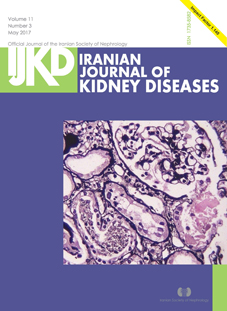Predictors of Clinical Outcomes in Hemodialysis Patients: a Multicenter Observational Study
Abstract
Introduction. Cardiovascular and noncardiovascular mortality and morbidity rates of hemodialysis patients are high despite improvement in dialysis delivery.
Materials and Methods. Hemodialysis patients (n = 532) from 9 hemodialysis facilities were enrolled in this cohort study in September 2012. Causes of death, hospitalization, and hemodialysis exit were recorded during a 28-month follow-up period. A Cox proportional hazard model was used to predict death adjusting for case-mix variables, nutrition variables, bone mineral variables, Kt/V, vascular access, and Charlson comorbidities index.
Results. Patients were 56.0 ± 15.4 years old (57% men). A total of 161 patients (30%) died (17 per 100 patient years), and the most common causes of death were cardiovascular diseases (42%) and infections (25%). Transplantation rate was 7 per 100 patient years and hospitalization frequency was 0.76 per patient year. Based on the multivariable Cox proportional hazard model, the mortality hazard ratio was 1.03 (95% confidence interval [CI], 1.01 to 1.05; P = .007) for age (years), 0.21 (95% CI, 0.11 to 0.40; P < .001) for serum albumin (g/dL), 1.21 (95% CI, 1.03 to 1.42; P = .02) for serum phosphorus (mg/dL), 1.001 (95% CI, 1.0005 to 1.002; P = .001) for serum intact parathyroid hormone (pg/mL), 1.58 (95% CI, 1.01 to 2.51; P = .047) for hemodialysis catheter (compared to arteriovenous fistula), and 1.75 (95% CI, 1.59 to 1.94; P < .001) for the Charlson score.
Conclusions. Nutritional factors, comorbidities, vascular access, and abnormal mineral metabolism are the main determinants of mortality and morbidity in hemodialysis patients.


